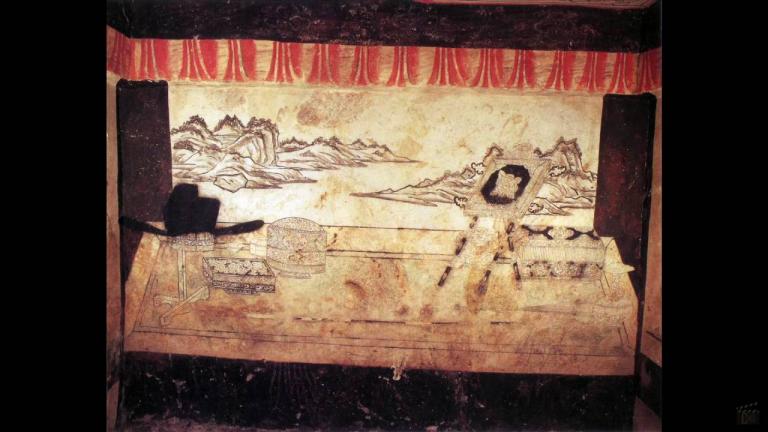Paintings in the Five Dynasties
4 min readAlthough the regime was transferred from one to another and the territory was disrupted in the Five Dynasties,the culture was still uniform.There were frequent economic exchange and culture communication among different regimes.In some places with developed economy and business prosperity,the art of painting also witnessed new transformation.Religious painting gave its way to scroll painting for appreciation.Landscape painting,flower-and-bird painting and figure painting al gained great development and new achievements.Some rulers even set up paintinginstitutions and gather famous painters to do brushwork only,which objectively facilitated the development of painting.

Landscape Painting
Landscape painters in the Five Dynasties carried out more observation and spent more time with nature,thus they knew nature better than painters in Sui and Tang dynasties.They paid more attention to the manifestation of artistic conception in landscape painting.Different painters were good at the depiction of different subject matters in different areas,hence formed various painting styles and schools.Jing Hao and Guan Tong were famous for their Northern landscape paintings;Dong Yuan and Ju Ran were known for their Southern landscape paintings;Wei Xian was good at architecture painting;And Zhao Gan had First Snow along the River.The famous landscape painters include:
Jing Hao,with Haoran as his courtesy name,titled himself Hongguzi.He was from Qinshui in Henei(Qinshui in Shanxi province today).As a painter experienced late Tang dynasty and Later Liang in the Five Dynasties,he was very learned in classical literature and history,especially good at poetry and essay writing.During the chaotic warring period of late Tang and Five Dynasties,he retreated to Honggu near Taihang Mountain,doing farming and painting at the same time.Other than tillage,he persisted in painting and would paint thousands of times for the best depiction of a pine tree.His landscape painting followed the water and ink painting from Tang dynasty,learning from the advantages and discarding the disadvantages.His paintings were usually panoramic depictions of northern scenery.His use of sketchlines and inks developed the painting skills of water and ink landscape painting.
Guan Tong was born in Chang’an(Xi’an in Shaaxi province).He learned landscape painting from Jing Hao.His works mainly depicted the mountainous scenery in the Guanzhong Plain,especially mountains in autumn,forests in winter,village residences,and ferries in the wild,intelligent hermits,fishing towns and mountain posts.He used simple lines to sketch the meaningful,brief figure of the exact image.His paintings were praised as”simple drawing yet with meaningful conception;concise depiction yet with lasting atmosphere”.The truthful depiction and winning conception of his paintings won him a title”Jing&Guan”together with Jing Hao.He was also listed together with Li Cheng and Fan Kuan as the”Three Painters”honored from Song dynasty.His works handed down include Waiting for a Ferryboat in a Mountain Valley and Traveling in the Guanshan Mountain.

Dong Yuan,with Shuda as his courtesy name,was from Zhongling(near Nanchang in Jiangxi province today).He was a painter in Southern Tang of the Five Dynasties and once served as assistant superintendent in Beiyuan,so he was also known as Dong Beiyuan in the painting history.According to the recordation,he could draw cattle,tiger and people,yet his landscape paintings were the most famous.He mainly depicted south of the Yangtze River region sceneries in a creative way.When seen closely,his painting was rough and far from the original images,yet seen from
afar, the scenery was really vivid and clear. The landscape painting style and painting skills created by Dong Yuan were inherited by Ju Ran and were canonized by literati and painters in Yuan dynasty. In Ming and Qing dynasties, his painting style and skill even became an orthodox school in the field of landscape painting and of great influence on the followers. His works include Summer Scenery: Waiting for a Ferryboat at the Mouth of Mountain, Xiang River and Imperial Suburb Residents have been handed down to posterity.
Ju Ran was also from Zhongling (near Nanchang in Jiangxi today). He was a monk painter in Southern Tang of the Five Dynasties. He used to be a monk in Kaiyuan Temple in Jiangning (Nanjing in Jiangsu province). After the doom of the Southern Tang dynasty, he went to Bianliang (Kaifeng in Henan today) with Li Yu, last emperor of Southern Tang. His landscape paintings followed Dong Yuan’s style and mainly depicted the beautiful scenery of southern China. In his paintings, ink was used in a moistening way to make the painting beautiful and likable. The peaks of mountains were usually covered with rocks. Ju Ran developed Dong Yuan’s scattered-hemp-like light-ink strokes and was honored together with Dong Yuan as “Dong & Ju”, who wereappreciated and influential among literati and painters in the Yuan, Ming and Qing dynasties. His works include Asking for the Way in an Autumn Mountain and Ten Thousand Gullies and Wind among Pine Trees.








